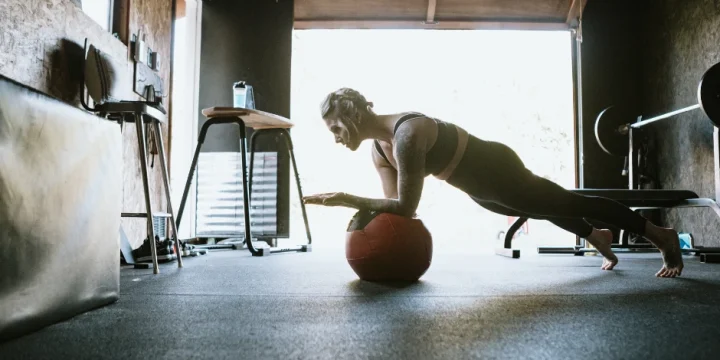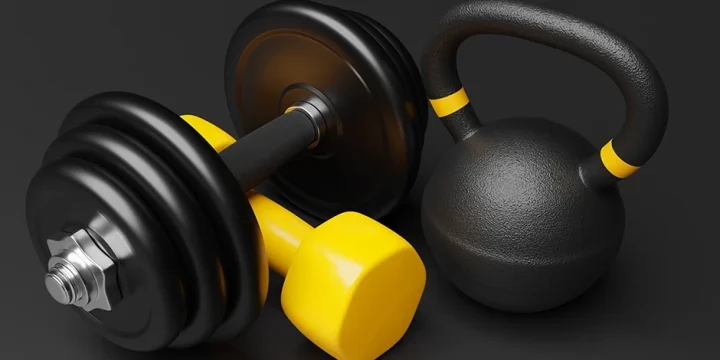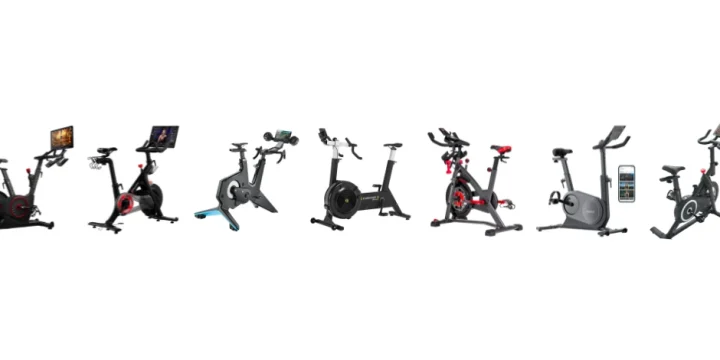From elementary PE to high school sports and adult fitness classes, jumping jacks are a staple exercise. Plyo jacks are a more involved and challenging variation of the classic exercise.
Even before I became a fitness trainer a decade ago, plyo jacks were a favorite because they are a dynamic, full-body exercise that effectively improves cardiovascular endurance and muscle power.
This article will detail how to do plyo jacks and discuss variations, benefits, and drawbacks.
Let’s jump in.
Quick Summary
- Plyo jacks are a more challenging variation of the classic jumping jack.
- Because plyo jacks increase your heart rate, they are good for cardiovascular health.
- A study published in the Journal of Sport and Health Science highlights how plyometric training, including plyo jacks can significantly contribute to muscle growth.
- Having seen the transformative impact on my clients, I'm convinced that plyo jacks are essential for a dynamic and effective fitness regimen.
How To Do Plyo Jacks

Plyo jacks involve similar movements as jumping jacks.
With jumping jacks, you jump your feet out wide on the ground.
With plyo jacks, you explode up from a squat as you jump your feet out wide.
Here is how to perform plyo jacks, but remember to keep the reps, sets, and pace appropriate for your fitness level:
- Start standing with your feet slightly apart and your arms by your side.
- Lower down into a half-squat position, then explosively jump up while separating your legs and arms overhead and outwards to create an “X” shape.
- As your feet land, immediately reverse the motion by rapidly bringing the legs and arms together to return to the starting position.
- That completes one repetition of plyo jacks. Keep good form throughout the exercise and focus on maintaining control of your body as you explode onto the platform and come back down.
- Repeat this motion until the desired number of repetitions is complete, and then rest before continuing if necessary.
Useful Tips
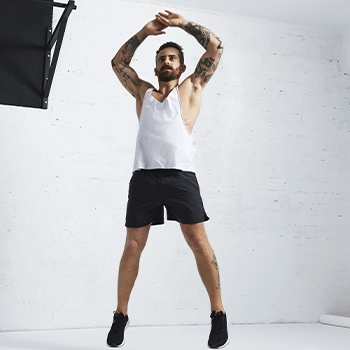
Keep these few things in mind when performing plyo jacks:
- Land properly on your feet. During the jump phase, land more on your toes than your heels. Allowing the heels to touch the ground first causes the knees to absorb the impact.
- Up the challenge. Dropping further into the squat position increases the difficulty of this exercise.
- Start slow with fewer reps. Especially if plyo jacks are a new exercise, you should make sure you slowly pick up the pace as you perfect the movement.
- Be gentle to your feet, knees, and hips. As with jumping jacks, perform plyo jacks on an even surface that is grass, rubber, or other shock-absorbing material. Try to avoid cement or asphalt.
- Choose proper footwear. I always advise my clients to choose shoes that provide ample ankle support and cushioning for the feet.
“It is widely accepted that two of the most efficient ways to burn fat and get lean are strength training and high-intensity interval training. Plyometrics, a form of strength training that requires jumping and repetition, is really a combination of the two.”
- Chris Freytag, Author at The American Council on Exercise (ACE)
Benefits of the Plyo Jack

Having trained numerous clients with plyo jacks, I can attest to their effectiveness. They're not just challenging; they significantly enhance overall physical fitness.
Let’s explore a few specifics.
1. It’s a Full-Body Workout
Because of the squat position, the explosive jump, and the extension of the arms overhead, plyo jacks effectively work many muscles, including the hamstrings and quads in the thighs, while also engaging the shoulders.
Additionally, the gluteus maximus, the largest muscle of the glutes and the primary hip extensor, is engaged. Healthy hips boost mobility, balance, and stability, making everyday activities like walking and climbing stairs easier.
2. You Will Burn Fat

Plyo jacks are an explosive, high-intensity fat-loss exercise that increases your heart rate and burns calories while building strength and endurance.
They require both lower body muscles, such as the quads, hamstrings, and calves, and upper body muscles, like the deltoids, to be actively engaged.
This dynamic, full-body exercise requires high explosiveness that helps shred fat.
3. It’s a Great Cardio Workout
Through my experience, I've found plyo jacks to be an excellent cardio workout.
Their fast pace and explosive movements effectively enhance cardiovascular fitness, elevating heart rate and increasing stamina.
Clients often report increased energy and improved stamina in daily activities, extending benefits to other endurance and conditioning-focused activities.
4. Your Muscles Will Grow
As a trainer, I've observed that plyo jacks, which engage the entire body, are highly effective for muscle gain.
The exercise's jumping motion activates muscles globally, with the lower body driving the movement and the arms and abs aiding in balance.
Research from the Journal of Sport and Health Science confirms the significant muscle-building impact of plyometric training, including plyo jacks [1].
My clients' experiences align with this, showing notable muscle development, particularly in the lower body, where plyometrics excel in muscle growth compared to upper body gains.
Comparable to Other Training Forms
Plyometric jumps, including plyo jacks, have a similar effect on balance improvement when compared to other training methods, such as specific balance training. This indicates that Plyo Jacks can be as effective as other specialized balance exercises.
Drawbacks
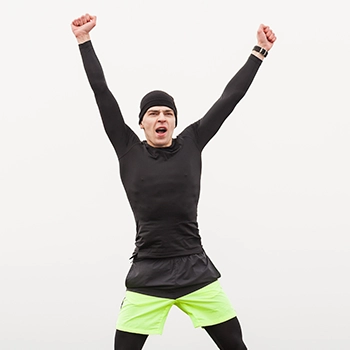
Below are the drawbacks associated with Plyo jacks:
Risk of Injury
Plyo jacks are explosive movements that stress the body, particularly the joints, which can lead to an increased injury risk if not performed correctly.
Based on my years of training clients, I cannot stress enough the importance of a proper warm-up. I've seen how a good warm-up routine can significantly reduce the risk of injury, especially with high-impact exercises like plyo jacks.
Not Suitable for Everyone
Individuals with certain health conditions, such as joint problems or cardiovascular issues, may find Plyo Jacks too strenuous or risky.
For those new to exercise, Plyo Jacks might be too challenging or intense, requiring a basic level of fitness to perform safely and effectively.
High Impact on Joints
Plyo Jacks are a high-impact exercise that can put significant stress on the joints, particularly the knees and ankles.
Related Articles:
FAQs
Should You Do Plyo Every Day?
You shouldn’t do plyo every day because it is a high-impact, demanding exercise on the joints. Limiting these workouts to 2-3 times a week allows for recovery in between plyometric exercise sessions.
Does Plyo Build Muscle?
Yes, plyo builds muscle very effectively because plyometrics is a type of resistance training designed to both stretch and contract the muscles, stimulating their development.
References:
- https://www.sciencedirect.com/science/article/pii/S2095254620300764?via%3Dihub
About The Author
You May Also Like


